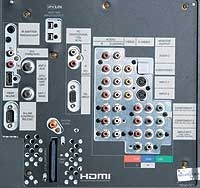Mitsubishi WD-52525 52-inch DLP HDTV Page 2
I was able to control my components through the TV, but NetCommand's onscreen interface is a bit cumbersome and its library of brand/model control codes is somewhat limited. The rest of Mitsubishi's menu system, however, was easy to navigate. I also appreciated the large, partly backlit remote, which offers an alternative to the NetCommand system by directly controlling up to four other devices. Its highlights include ample finger space, a rocker-type input selector, and a big, easy-to-use cursor control.
 Mitsubishi always seems to go the extra mile on the back-panel input bay, and this TV is no exception. Its generous array of connectors includes an HDMI (High Definition Multimedia Interface) port, which I used - along with an adapter cable - for the DVI (Digital Visual Interface) output of a Bravo D1 DVD player. The WD-52525 is also among the first HDTVs to have a CableCARD slot, which looks like the PC Card slots used in laptops for Wi-Fi cards and other accessories. When a CableCARD is inserted and activated by the cable company, you can decode premium digital channels without a cable box.
Mitsubishi always seems to go the extra mile on the back-panel input bay, and this TV is no exception. Its generous array of connectors includes an HDMI (High Definition Multimedia Interface) port, which I used - along with an adapter cable - for the DVI (Digital Visual Interface) output of a Bravo D1 DVD player. The WD-52525 is also among the first HDTVs to have a CableCARD slot, which looks like the PC Card slots used in laptops for Wi-Fi cards and other accessories. When a CableCARD is inserted and activated by the cable company, you can decode premium digital channels without a cable box.
But there's a catch: you have to lease the card from your cable company, and because the current Digital Cable Ready standard for HDTV supports only one-way communication - from cable company to TV, not vice versa - using a CableCARD means you won't get the cable company's program guide or be able to take advantage of any video-on-demand services it may offer. Of course, CableCARD is only an option - you can still use a cable box if those features are important to you. I verified that the set's CableCARD slot was functional but used a Dish Network DVR 921 HDTV satellite receiver as the high-def program source. (For more on CableCARD, click to read "Wild Card.")
Since lamp life is a potential concern among owners of DLP TVs, the WD-52525 is thoughtfully designed to display a message after 4,000 hours of use advising you that it's time to start thinking about replacing the lamp. A new one is $299, but in the first year it's covered by the warranty.
The WD-52525 offers six display modes for standard-def sources, including one that places black bars to either side of the screen and one that stretches the sides of the image. With high-def sources, you're limited to two modes: Standard and Wide Expand, which stretches the image horizontally. Numerous picture adjustments are provided, including the ColorPerfect controls for fine adjustment of color balance, three color-temperature presets, and DefinEdge, which adds edges around onscreen objects to increase perceived sharpness - this should be used only with standard-def TV and other low-resolution sources. The Mitsubishi remembers picture settings separately for each input, which made it easy for me to set up one input for my DVD player, another for satellite HDTV, and so on.













































